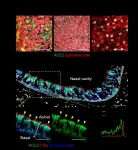(Press-News.org) In Canada, low-income hospital patients under palliative care are less likely to receive medical assistance in dying compared to those who are high income, according to a study published in British Medical Journal Open (BMJ Open).
Medical assistance in dying (MAID) is legal and free under Medicare, Canada's universal health care system. Patients with low socioeconomic status (SES), however, generally tend to experience less access to medical care compared to their high SES counterparts.
Eldar Shafir, professor of psychology and public affairs at the Princeton School of Public and International Affairs, along with a team of researchers from Sunnybrook Hospital in Ontario, investigated whether this trend of decreased care for low-income patients includes medical assistance in dying.
"I have long been interested in SES influences on decision-making," said Shafir. "I often discuss with my friend and collaborator, Dr. Redelmeier, ways to illustrate some of our findings in the medical realm, especially, when possible, among experts. ... In this case MAID was a really interesting domain, since it's a 'big' decision, and finances are not an issue."
Medical assistance in dying was ruled legal in Canada in February 2015 and officially implemented and covered under Medicare by June 2016. To be considered, a patient must have a grievous and irremediable medical condition, such as metastatic cancer, that causes unbearable suffering where death is foreseeable, according to the Government of Canada.
However, one's socioeconomic status can influence how medical care is administered and received by a patient in several ways. "People can be easily susceptible to pitfalls and biases in reasoning," Shafir said.
Low-income patients, for example, may feel less equipped to advocate for their care and to convey dissatisfaction. Clinicians can also succumb to the "thick-skin fallacy," or the harmful perception that low-income people are used to hardship and therefore less impacted by it.
The team explored the association between socioeconomic status and medical assistance in dying by identifying hospital patients aged 65 and older in Ontario, Canada between June 2016 and 2019. At the time of their death, all patients, all of whom had serious medical conditions, were under palliative care, receiving pain-relieving treatment for symptoms. They were then divided into groups based on socioeconomic status, which was calculated using an official algorithm created by Statistics Canada based on home neighborhood location, and whether they received medical assistance in dying.
During the three years, 50,096 patients were given palliative care in their last month of life. Among them, 920 received medical assistance in dying. Only 1.5% of low-income patients identified were given MAID, compared to 2.4% of high-income patients -- a 39% decreased likelihood for those with low socioeconomic status. This disparity in care was found consistently across a variety of patient subgroups that varied in age, sex, home location, type of cancer, health care utilization, and general frailty. It was even replicated with patients treated by the same responsible physician.
The study's results support past findings by other countries about the relationship between medical assistance in dying and patients' socioeconomic status. In countries like the United States, the Netherlands, Switzerland, and Belgium, people who received MAID or MAID equivalents tended to be highly educated, financially secure, or live in wealthy neighborhoods.
The researchers, however, suspect that this difference in patient care may be influenced by factors that exist outside of financial capabilities. "I suspect most of what happens here is a function of the doctor-patient interaction," explained Shafir. "I think, all else equal, that doctors might see low-SES patients as less in urgent need of MAID."
Certain study limitations, such as biased and imperfect socioeconomic status measures, warrant further research exploring the link between social class and medically assisted death. "Both perspectives, the doctors' and the patients', need to be better understood by the medical community in order to provide low-SES patients with same care afforded those of higher SES," said Shafir.
The observations made by Shafir and his team address an earlier misconception in Canada that medical assistance in dying may harmfully target low-income individuals. The researchers are optimistic that their findings may help promote greater patient-clinician communication and engagement.
INFORMATION:
"Association of socioeconomic status with medical assistance in dying: a case-control analysis" by Donald A. Redelmeier, Kevin Ng, Deva Thiruchelvam, and Shafir, was published on April 30 in British Medical Journal Open.
Imaging spectroscopy can help predict water stress in wild blueberry barrens, according to a University of Maine-led study.
The technology involves measuring the light reflected off of objects depicted in images captured by drones, satellites and other remote sensing technology to classify and gather pertinent information about the objects. According to researchers, it can precisely measure light across dozens, if not hundreds, of bands of colors. The reflectance spectra can depict nutrient levels, chlorophyll content and other indicators of health for various crops, according to researchers.
Scientists from UMaine, the Schoodic Institute and Wyman's, one of the world's largest purveyors of wild blueberries and ...
More than 80 percent of people around the world consider themselves to be religious or spiritual. But research on the neuroscience of spirituality and religiosity has been sparse. Previous studies have used functional neuroimaging, in which an individual undergoes a brain scan while performing a task to see what areas of the brain light up. But these correlative studies have given a spotty and often inconsistent picture of spirituality. A new study led by investigators at Brigham and Women's Hospital takes a new approach to mapping spirituality and religiosity and finds that spiritual acceptance can be localized to a specific brain circuit. This brain circuit is centered in the periaqueductal gray (PAG), a brainstem region that has been implicated ...
Over the last two decades, biomaterials research has made significant progress, transitioning from traditional biomaterials to biomaterials with controlled structure and dynamic functionality. A number of building blocks have been explored for developing biomaterials by self-assembly, but SAPs have garnered special attention due to their tunability and potential use in various applications such as tissue engineering, wound healing, and vaccinations. Despite these benefits, the SAP-based approach is less explored in the intracellular context.
Fortunately, a team of scientists from the Tokyo Institute of Technology (Tokyo Tech), led by Assistant Prof. Takayuki Miki, have reported a de novo peptide, Y15, that ...
Boulder, Colo., USA: The Geological Society of America regularly publishes
articles online ahead of print. GSA Bulletin topics include
multiple articles about the dynamics of China and Tibet; the end-Permian
terrestrial extinction paradigm in South Africa; prehistoric lava flows
from the urban district of Catania (Etna volcano, Italy); the debated
origins of granite, and "a tale of two Tweefonteins." You can find these
articles at
https://bulletin.geoscienceworld.org/content/early/recent
.
Authigenic berthierine and incipient chloritization in shallowly ...
Most babies born prematurely or with health problems are quickly whisked away to the Neonatal Intensive Care Unit (NICU) where they might require assisted heating devices to regulate their temperature. A University of Houston College of Nursing researcher is reporting that the traditional use of cloth blankets and towels during peripherally inserted central catheter (PICC) placement may hinder heat transfer from the assisted heating mechanisms, increasing the risk for neonatal hypothermia. In Advances in Neonatal Care, Huong (Kelle) Phan, clinical assistant professor, reports that a plastic drape lowers the incidence of hypothermia.
"The use of the plastic drape is a quality improvement to reduce the hypothermia rate in very low birth-weight ...
WILMINGTON, Del. (June 29, 2021) - A new report finds that 509,025 (9.17%) public high school students in 24 states experienced homelessness in spring 2019 -- three times the number recognized by the states' education agencies. This under-recognition creates gaps in funding and services needed by this vulnerable population.
Researchers from Nemours Children's Health and the University of Pennsylvania analyzed data from the Centers for Disease Control and Prevention (CDC) for public schools across 24 states and 12 school districts. During spring 2019, more than 9% of public high school students experienced homelessness during a 30-day period in the 24 states. The rate was even higher in the 12 school ...
New research published today in the journal Blood Advances finds that certain factors, such as a history of severe pain episodes and coexisting organ conditions, increase the risk of severe COVID-19 illness, including hospitalization, in individuals living with sickle cell disease (SCD). According to researchers, the study results underscore the need for COVID-19 risk reduction strategies and vaccination for this medically vulnerable population.
SCD is the most common inherited red blood cell disorder in the United States, affecting an estimated 100,000 people. According to the Centers for Disease Control and Prevention, SCD affects one out of ...
Understanding how viral infection occurs can provide important clues for researchers to develop strategies to prevent viral transmission and develop effective therapeutic agents and vaccines. SARS-CoV-2, the causative agent of COVID-19, enters the host cells through interaction between the virus's spike protein and the extracellular receptor binding domain of ACE2. The viral entry into the cells is completed by various proteases, which allow the viral and cell membranes to fuse together. While it is known that the upper respiratory tract becomes compromised in the early infection, the exact types of the cells that the virus infects at the earliest stage have not yet been identified.
Led by Director ...
New research from the Institute of Psychiatry, Psychology & Neuroscience (IoPPN) at King's College London, in collaboration with the University of Liverpool and the Karolinska Institute, has shown that many of the symptoms in fibromyalgia syndrome (FMS) are caused by antibodies that increase the activity of pain-sensing nerves throughout the body.
The results show that fibromyalgia is a disease of the immune system, rather than the currently held view that it originates in the brain.
The study, published today in the Journal of Clinical Investigation, demonstrates that the increased ...
Extreme differences in flight altitude between day and night may have been an undetected pattern amongst migratory birds - until now. The observation was made by researchers at Lund University in Sweden in a study of great snipes, where they also measured a new altitude record for migratory birds, irrespective of the species, reaching 8 700 metres.
Great snipes are shorebirds that breed in Sweden, among other places, and spend the winter in areas near the equator in Africa. Previous studies have shown that great snipes make long marathon flights of up to 6 000 kilometres lasting 60-90 hours when they migrate between breeding sites in Sweden and wintering ...



